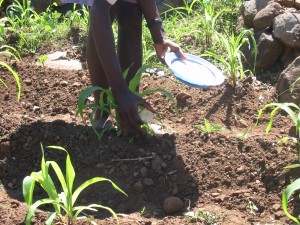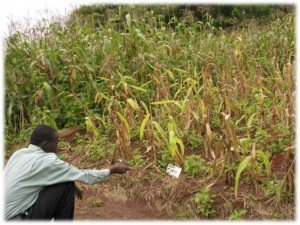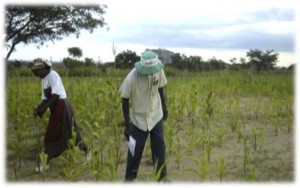Nitrogen- It’s What’s For Dinner
Description
 Although plants require both macronutrients (i.e. N,P,K) and micronutrients, nitrogen (N) is the lynchpin. It is needed in the largest quantities and is most often the limiting factor for growth and production of food on smallholder farms. Phosphorus (P) is the other major growth-limiting nutrient and is an essential facilitator in ensuring plant access to N, so it should be considered in tandem. Below we discuss the role of N in relation to soil fertility and consider how it is currently recommended and supplied to smallholder farmers. We also explore how employing agroecological principles that match N supply to actual plant requirements could improve productivity, profitability, and sustainability.
Although plants require both macronutrients (i.e. N,P,K) and micronutrients, nitrogen (N) is the lynchpin. It is needed in the largest quantities and is most often the limiting factor for growth and production of food on smallholder farms. Phosphorus (P) is the other major growth-limiting nutrient and is an essential facilitator in ensuring plant access to N, so it should be considered in tandem. Below we discuss the role of N in relation to soil fertility and consider how it is currently recommended and supplied to smallholder farmers. We also explore how employing agroecological principles that match N supply to actual plant requirements could improve productivity, profitability, and sustainability.
In order to more effectively and economically improve crop productivity, it is important to understand the underlying principles of managing nitrogen (N). Of all nutrients, N is generally required in the greatest quantities and is also most frequently limiting to terrestrial plant productivity. Nitrogen is essential to the photosynthesis process, the driver of plant productivity. Large quantities of both N and P are required to build the photosynthesis apparatus[1]. Nitrogen must be “fixed” from the atmosphere into plant available forms in order to be utilized for plant production. This process is highly energy demanding, with biological N fixation (BNF) as the major source in agriculture, and lightening a minor source. The proportion of N plants capture from fertilizer (through the Haber-Bosch N fixation process) varies greatly with management system and socio-economic context. Nitrogen availability is further regulated by the decomposition (mineralization) of soil organic matter.
Phosphorus availability must be considered in close connection to N, as P is the key to energy transformations in all organisms. This includes the high energy-demand of biological fixation of N by plants and their symbiotic microorganism partners. Legume crops are a prime example of a BNF-reliant species type, and not surprisingly tend to require large amounts of P. Legumes have developed root traits and other plant properties to enhance P availability and efficient use, to support the high-energy demands of biological fixation (Bonser et al., 1996). In turn, legumes with an adequate P supply integrated into a farming system can reduce the requirement for external N (Snapp et al., 2003). Soil P pools are often large; however, the amount available to a plant at any point in time involves a minuscule pool, regulated by complex factors such as the soil matrix, biology and chemistry (Drinkwater and Snapp, 2007) (learn more about P). Other nutrients generally play minor roles, as soil parent material and soil organic matter mineralize sufficient micronutrients to support plant growth at moderate levels.
Overall, plant productivity is highly responsive to N additions- with the noted exception of legumes which are self-sufficient through BNF. Profitable use of fertilizers most often involves small doses of targeted N fertilizer, in contrast to the rather high doses and blanket fertilizer recommendations of NPK fertilizer that are common in the region (Snapp et al., 2014). Small doses of N can achieve large crop growth responses on smallholder fields, particularly in improved varieties of cereals such as maize hybrids – as has been shown in studies across Africa (Diarisso et al., 2015; Ngoze et al., 2008). However, this is rarely obtained, and this gap between potential and achieved yields is a topic of intensive research (Tittonell and Giller, 2013).
To explain this yield gap, both immediate and long-term crop requirements for N demands careful consideration. Immediate requirements involve management of N inputs and weeds to ensure sufficient supply with minimal competition). Long-term nitrogen management is mediated via replenishment of soil organic matter for N mineralization and healthy crops that respond to N applied. For example, although high-analysis N containing fertilizers such as urea are often the most profitable when a crop is considered in isolation, multiple crops are generally grown over time and space on smallholders’ farms. A combination of N and P fertilizer sources applied to legume crops grown in rotation or as mixtures with cereals may be more a profitable approach to input use, where the entire farm is considered (Snapp et al., 1998).
Despite continued dominance of research on inorganic fertilizers used in isolation, there are additional methods of meeting crop N requirements that are feasible in a smallholder context. Management practices that reliably reduce micronutrient deficiencies include enhancement of soil organic matter and soil pH amendment (manure or lime). There is widespread agreement that biogeochemical processes – mediated largely by soil organic matter – supply the vast majority of the fixed-N and solubilized-P on smallholder farms. Integrated nutrient management approaches offer a synergistic mechanism drawing on both inorganic nutrient sources and agroecological approaches. There is also evidence that diversification of plant and animal species, and good husbandry for vigorous seedlings and deep root growth, can improve nutrient uptake. This has been shown to be a trait of multipurpose and indeterminant long-lived crops such as pigeonpea (Cajanus cajan).
Sustainability of the N and P management will depend on where system boundaries are drawn, as a ‘mass balance’ approach of replenishing nutrients removed is in essence advocating mining nutrients from one location to apply to fields in another location (Snapp, 1999). This requires reliance on finite natural resources, such as P reserves and fossil fuels used for the energy-intensive N fixation process. Thus in our view, the extent to which N and P nutrient cycles can be tightened is key to sustainability and profitability of farming. Volatility of inorganic fertilizer prices places farmers at additional economic risk.
Our applied agroecology approach considers how biology can be managed so as to enhance biological N fixation and solubilization of P to enhance available forms of these key macro nutrients to support plant growth (Drinkwater and Snapp, 2007). Through a synchrony of supply and demand where the supply of nitrogen is mineralized at the exact time when the crop needs it, it is possible to enhance nitrogen efficiency. This reduces negative impacts of agriculture from excess leakage of nitrogen into water and air. In partnership with researchers, extension, smallholder farmers and other collaborators we continue to co-learn about how to improve nitrogen efficiency (Chikowo et al., 2014). A N fertilizer management guide (pdf here) was recently produced as a multi-institution, collaborative effort of Africa RISING-Malawi, USAID, MSU, IITA, IPNI and CABI (Waddington, et al., 2015), including identification of recommended steps for policy makers and research gaps, as well as management recommendations.
[1] The ubiquitous presence of the protein RuBisCo in plants requires large amounts of N as building blocks for this enzyme that catalyzes the first step in capturing and fixing carbon from a gaseous form into simple sugars.
Principles:
- Harnessing biological processes can improve N and P cycling efficiency and support sustainable, profitable crop production.
- Relies on the agronomic principle that matching supply and plant N requirements, which is critical to protect natural resources.
- A focus on managing the nutrients (N and P) needed in macro-supply is appropriate for the vast majority of smallholder farmers and soil types.
- Nutrients such as K, S, Zn and Ca are needed in conjunction with N and P, and anomalous vegetation color or tissue distortion can be a warning sign of deficiencies, but in most cases soil organic matter mineralization and biology-mediated solubilization can supply sufficient nutrients to improve yields several fold.
Debates:

From along-term field experiment in Makoka Experiment station, southern Malawi where in the foreground continuous, sole maize has been fertilized for two decades and soil organic matter has declined. Agroforesty tree intercrops have maintained soil nitrogen status and maize health in the adjacent plot.
- How to develop management recommendations that take into account the complex factors that influence nitrogen supply to crops? This includes soil biology and heterogeneity, complexity of crop rotation, management history, goals of farmers and profitability.
- Does improved soil organic matter management remain the most feasible means for smallholders to address these deficiencies? Will it be sufficient? Under what circumstances?
Learning Lab Resources:
Bonser, A.M., J.P. Lynch and S.S. Snapp. 1996 Gravitrophic response to low P and root architectural traits in common bean. New Phytologist 132:281-288.
Chikowo R, Zingore S, Snapp S, and Johnston A 2014. Farm typologies, soil fertility variability and nutrient management in smallholder farming in sub-Saharan Africa. Nutr Cycl Agroecosyst 100:1–18.
Cichy, K.A., G.V. Caldas, S.S. Snapp and M.W. Blair. 2009. QTL analysis of seed iron, zinc, and phosphorus levels in an Andean bean population. Crop Science 49:1742-1750.
Drinkwater, L.E. and S.S. Snapp. 2008. Nutrients in agroecosystems: Rethinking the management paradigm. Advances in Agronomy. 92: 163-186.
Kumwenda, J.D.T., S.R. Waddington, S.S. Snapp, R.B. Jones, and M.J. Blackie. 1997. Soil fertility management in Southern Africa. pp. 153-172. In: D. Byerlee and C.K. Eicher (Eds.) Africa’s Emerging Maize Revolution. Lynne Publishers, Boulder, CO.
Snapp, S.S., T.S. Jayne, W. Mhango, T. Benson and J. Ricker-Gilbert. 2014. Maize yield response to nitrogen in Malawi’s smallholder production systems. Working Paper 9. Malawi Strategy Support Program. IFPRI.
Snapp, S.S., R.B. Jones, E.M. Minja, J. Rusike and S.N. Silim. 2003. Pigeon pea for Africa: A versatile vegetable – and more. HortScience. 38:1073-1078.
Snapp, S.S., P.L. Mafongoya and S. Waddington. 1998 Organic matter technologies to improve nutrient cycling in smallholder cropping systems of Southern Africa. Agriculture, Ecosystems and Environment 71:187-202.
Snapp, S.S. 1999. Phosphorus and sustainability of sub-Saharan Africa smallholder farms. pp. 59-72. In J.P. Lynch, J. Deikman (Eds.) “Phosphorus in Plant Biology: Regulatory Roles in Molecular, Cellular, Organismic & Ecosystem Processes” American Society Plant Physiol., Rockville, MD, USA.
Snapp, S.S. 1998 Soil nutrient status of smallholder farms in Malawi. Communications in Soil Science and Plant Analysis 29:2571-2588.
Waddington, S.R., S. Zingore, R. Chikowo, L. Wairegi, and S. Snapp. 2015. Integrated Fertilizer Policy Guide for Maize-Legume Cropping Systems in Malawi. Africa-RISING, Michigan State University, IITA, IPNI, CABI. https://cgspace.cgiar.org/handle/10568/6889.
Links:

Degraded soils: Field in Zimbabwe where nitrogen losses and soil organic matter depletion has undermined crop growth, making agriculture risky.
N fertilizer management guide produced as a multi-institution, collaborative effort of Africa RISING-Malawi, USAID, MSU, IITA, IPNI and CABI
N2Africa– Putting nitrogen fixation to work for smallholder farmers in Africa
Extended Bibliography and Works Cited:
Bekunda, M. A. Bationo and H. Ssali. 1997. Soil fertility management in Africa: A review of selected research trials. In: R. J. Buresh, P. A. Sanchez, and F. Calhoun (Eds) American Society of Agronomy and Soil Science Society of America, Madison, WI 53711, USA. Replenishing Soil Fertility in Africa. SSSA Special Publication no. 51., pp. 63-80.
Brodrick, S.J., F. Amijee, J.A. Kipe-Nolt, and K.E. Giller. 1995. Seed analysis as a means of identifying micronutrient deficiencies of Phaseolus vulgaris L. in the tropics. Trop. Agric.(Trinidad) 72:277-284.
Burke, W., T. Jayne, and J.R. Black. 2016. Factors explaining the low and variable profitability of fertilizer application to maize in Zambia. Agricultural Economics, 48, 1-12.
Diarisso, T., M. Corbeels, N. Andrieu , P. Djamen, J-M Douzet, and P. Tittonel 2015 Soil variability and crop yield gaps in two village landscapes of Burkina Faso Nutr Cycl Agroecosyst DOI 10.1007/s10705-015-9705-6.
Liverpool-Tasie, L.S.O (2016).
Is fertilizer use inconsistent with expected profit maximization in sub-Saharan Africa? “The case of rice in Nigeria”. Journal of Agricultural Economics. doi: 10.1111/1477-9552.12162
Ngoze, S. S. Riha, J.Lehmann, L. Verchotz, J. Kinyangi, D. Mbugua, and A. Pell. 2008. Nutrient constraints to tropical agroecosystem productivity in long-term degrading soils Global Change Biology 14: 2810–2822, doi: 10.1111/j.1365-2486.2008.01698.x
Tittonell, P. and K.E. Giller, 2013. When yield gaps are poverty traps: the paradigm of ecological intensification in African smallholder agriculture. Field Crops Research. 143:76-90.
Tittonell P, Vanlauwe B, Leffelaar PA, Rowe EC, Giller KE (2005a) Exploring diversity in soil fertility management of smallholder farms in western Kenya. I. Heterogeneity at region and farm scale. Agric Ecosyst Environ 110:149–165.
Wang X, Yan X, Liao H (2010) Genetic improvement for phosphorus efficiency in soybean: a radical approach. Ann Bot (Lond) 106: 215–222.

Close up of N deficiency in maize plant.
Challenges Addressed: Poverty and Food Insecurity, Soil Quality & Low Productivity, Poor Access to Organic and Inorganic Inputs, Socioeconomic and Political Economic Barriers, Contested Agronomy: Moving Beyond Silver Bullets, and Nitrogen, Carbon, and Phosphorus as Drivers
Tags: Agricultural Economics, Agronomy, Development, Extension, Soil Science, Sustainability Science
 Although plants require both macronutrients (i.e. N,P,K) and micronutrients, nitrogen (N) is the lynchpin. It is needed in the largest quantities and is most often the limiting factor for growth and production of food on smallholder farms. Phosphorus (P) is the other major growth-limiting nutrient and is an essential facilitator in ensuring plant access to N, so it should be considered in tandem. Below we discuss the role of N in relation to soil fertility and consider how it is currently recommended and supplied to smallholder farmers. We also explore how employing agroecological principles that match N supply to actual plant requirements could improve productivity, profitability, and sustainability.
Although plants require both macronutrients (i.e. N,P,K) and micronutrients, nitrogen (N) is the lynchpin. It is needed in the largest quantities and is most often the limiting factor for growth and production of food on smallholder farms. Phosphorus (P) is the other major growth-limiting nutrient and is an essential facilitator in ensuring plant access to N, so it should be considered in tandem. Below we discuss the role of N in relation to soil fertility and consider how it is currently recommended and supplied to smallholder farmers. We also explore how employing agroecological principles that match N supply to actual plant requirements could improve productivity, profitability, and sustainability.



